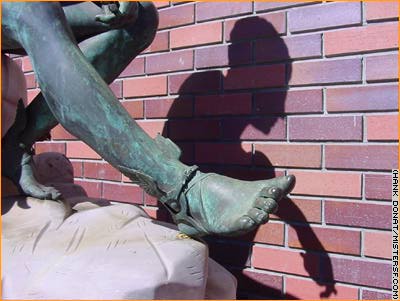
Detail, Resting Hermes
|
08/31/04
Hermes and me, High on a Hill part 2
by
Hank Donat
It will come as
no surprise to the reader that I haven't stopped cursing the rogues
who snatched the Resting Hermes sculpture from its pedestal on California
Street last week. The 300-lb bronze depicting the Greek god of merchants
and shepherds - as well as travelers, translators, and some other things
- was nabbed from the sidewalk outside the University Club under cover
of night.
The statue was originally sent to San Francisco by J. Chivarri & Co.
of Napoli for the Italian Exhibit at the Panama Pacific International
Exposition in 1915. By hosting the exposition, San Francisco officially
rose from the ashes and returned to the world stage after the 1906 earthquake
and fire.
Later, the University Club purchased Resting Hermes for $300. It was
stolen in 1974 and recovered following a plea by the newspaper columnist
Herb Caen.
Caen, as every San Franciscan knows, won the Pulitzer Prize in 1996
and died in 1997. But, what of Hermes? Who is this wing-footed character?
Hermes was the messenger and herald of the gods. Among his legends,
Hermes slayed Argos after putting the 100-eyed giant to sleep with voluminous
tales of Hermes' own adventures. As a messenger, his travels and exploits
were many.
A closer look suggests Hermes may have gotten his just desserts in Baghdad
by the Bay, for he was also a sneak thief. He stole Zeus's scepter,
Poseiden's trident, Aphrodite's girdle, and, most famously, Appolo's
cattle. Hermes may have invented the cover of night, as he was the first
sandman. Just ask Argos.
But does that mean the sprightly god found his ultimate karma along
the cable car line? Don't ask me; I only live here. I'll miss the statue
on the sidewalk near the Twins Armoire boutique and the Fairmont hotel
because it was graceful and beautiful. It represented the triumphant
rise and stealth determination of my City and Caen's. For that, I'm
sorry to see Hermes flee this gilded cage of ours, even if he was dragged
out of it.
It's quite something to watch the repair work on the outside of the
dome at the Palace of Fine Arts, which also dates back to the Pan-Pacific
Expo. Workers straddling the dome look like ants climbing a hill, or
even tinier depending on your perspective. The rib-like construction
of the dome was apparent all month as workers applied fresh building
materials in order to restore the structure, which was last refurbished
in 1967.
Some have admired
the golden orange color of some repaired sections. The dome will not
be returned to its previous slate gray when all is said and done. The
new hue was selected to match the original burnt orange of 1915 and
was approved by the Landmarks Preservation Advisory Board. Donna Ewald
Huggins and the Maybeck Foundation are the driving forces behind the
work. Visit maybeck.org.
It's true that the Palace of Fine Arts is an enduring international
symbol of San Francisco. Not so Resting Hermes. But there are many things
worth preserving about our daily lives in San Francisco that are more
obscure still. The click-clack-click that sounds like manic typing as
people browse through the Amoeba record store on Haight Street is the
first thing that comes to mind. It would be a shame to lose that if
the CD ever goes away in favor of online music.
The raucous flock of wild parrots from Telegraph Hill is flying overhead
at this moment, as if to remind me of their place in the pantheon of
the obscure yet unforgettable. Of course, the parrots are becoming less
obscure as time goes by. Not only are their numbers growing, Judy Irving's
documentary, "The Wild Parrots of Telegraph Hill," has been picked up
by a distributor for national release in 2005.
Over at the Presidio Theatre on Chestnut Street, where the marquee said
"Reopening Early 2004!" for several months, there is finally progress.
The sign now says, "Reopening 2004!" The theatre's owners tell neighbors
they'll open by the end of the year. Promises, promises.
The street in front of the Presidio Theatre, Bechelli's and other businesses
had been sinking slightly in recent years. It's a common problem, or
so some DPW types tell me. The street in the Marina bowed just enough
to attract mosquitoes and cause stinky gutters due to runoff. A recent
repaving job corrected the problem. You heard right - Chestnut Street
just got straighter.
While we're on the subject of streets, Jim Bryan wants to know if SoMA's
Minna, Tehama, Clara, and Louisa streets are inspired by an area of
streets with the same names in the same order in Brooklyn, NY. Bryan
says this question stymied Caen when Bryan asked him about it in the
1980s. Published references for Tehama Street cite the Tehama Indian
tribe of the Sacramento delta, with no reference to Brooklyn. The names
may only be a coincidence, or a minor mystery that endures in the city
of Hermes' unrest.

Welcome to MisterSF.com. Please visit the site
often to keep in touch with San Francisco, for your own amusement, and
to use the Local Joints
section as a portal for independent businesses. Keep your money in the
neighborhoods... Watch this space for observations, interviews
and more from around town. All other sections of MisterSF.com are also
updated continually, so come back and watch us grow!
Contact MisterSF.com
|
